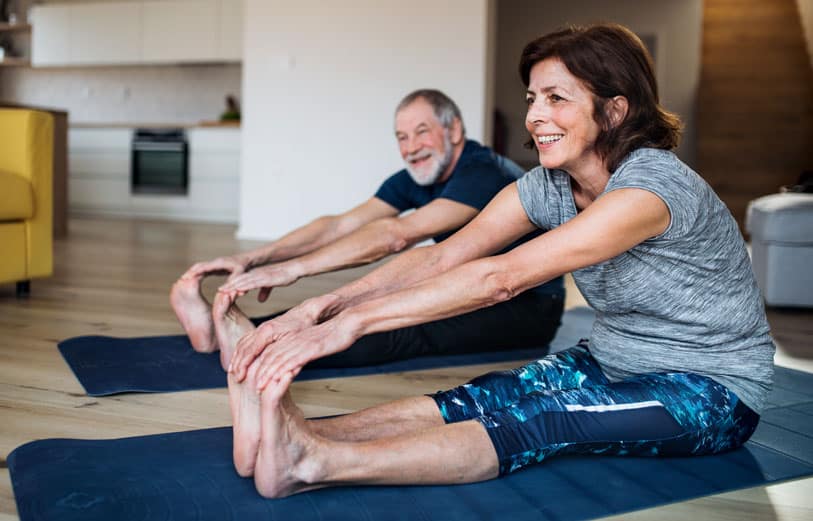Wintertime Indoor Exercise: Healthy and Cost-Effective

Discover how exercising indoors during the winter season can benefit your health.
How can you avoid becoming "seasonally" inactive?
Physical inactivity can lead to weight gain, decreased cardiovascular health, and a potential decline in your mental well-being. To counteract these effects, find ways to include indoor physical activity in your daily routine.
Here are some good ideas about how increasing your indoor activity can benefit you and some helpful tips to get moving at home today.
What are the benefits of regular exercise during the winter months?
As we all know, regular physical activity can help you maintain (and even lose) weight and enhance your cardiovascular health.
However, it does more than that. Regular exercise can strengthen your immune system, helping you fend off those nasty winter colds.
Additionally, regular exercise can elevate your mood, lessening the winter blues and seasonal depression many of us experience during the cold, bleary winter months.
What exercises can I do at home during the winter months?
Here are 10 simple indoor exercises that can be done at home by anyone wanting to begin an exercise program:
- Walking in Place: Simply walk in place in your living room or hallway (or throughout your house) to increase your heart rate and improve circulation. Lifting your knees or increasing your pace will increase the exercise benefit you receive from this activity.
- Step-Ups: Use a sturdy step stool or bottom stair to step up and down, alternating legs. This exercise works the lower body.
- Wall Push-Ups: Stand (or sit) facing a wall and place your hands shoulder-width apart on the wall. Perform push-ups against the wall to strengthen the chest, arms, and shoulders.
- Seated Torso Twists: Sit on a chair with your feet flat on the floor in front of you. Hold a lightweight object like a water bottle or can and gently twist your torso from side to side, engaging your core muscles.
- Arm Circles: Stand (or sit) with your feet shoulder-width apart and extend your arms to the sides. Make small circles with your arms forward, then reverse the direction to work the shoulder muscles.
- Leg Raises: Sit in a chair or lie on your back. If possible, extend one of your legs straight and lift it off the ground a few inches, then lower it back down. Repeat with the other leg to strengthen the hip flexors and core. This exercise can also be done with legs bent, if necessary.
- Kitchen Counter Push-Ups: Stand facing a kitchen counter and place your hands shoulder-width apart on the counter. Keep your back straight and perform push-ups against the counter to strengthen the arms and chest.
- Bicep Curls with Water Bottles: Stand or sit and hold a water bottle (or canned good) in each hand with your arms next to your sides. Extend your arms straight down, palms toward the front of your body. Bend your arms at the elbows, curl the bottles up towards your shoulders, then lower them to work the biceps.
- Heel Raises: Stand with your feet hip-width apart, rise up on your toes, then lower your heels back down. This exercise strengthens the calves. This exercise can also be performed seated.
- Seated Shoulder Press: Sit on a chair with a straight back and hold a lightweight object in each hand. Extend your arms overhead, then lower them back to shoulder height to work the shoulder muscles.
These exercises require minimal time and equipment and can be done in the comfort of your home. Because the exercises are simple and can be modified to fit your comfort and pace, they are ideal for beginners.
How can you make your indoor exercise safe and effective?
An appropriate exercise program can empower individuals to take control of their health and well-being, regardless of age or physical limitations.
When possible, exercise with a friend. Not only does it make exercise more fun, but it can also improve safety (and the likelihood of continuing to exercise) for both of you.
Consult your healthcare provider before implementing a new exercise routine if you have any medical conditions or concerns. Additionally, the Moultrie County Health Department (MCHD) encourages you to:
- Make sure you are nourished and remain well-hydrated before, during, and after exercise.
- Always prioritize safety when exercising.
- Hold onto a chair or other sturdy object for balance if necessary.
- Stand or sit straight and use controlled movements to minimize your risk of injury and discomfort.
- Start with a gentle warm-up.
- Begin your exercise program slowly and gradually increase intensity as your fitness improves.
- Modify the exercises to fit your physical ability and comfort.
- Pay attention to your breathing – you should be able to breathe comfortably while performing these exercises.
- Always listen to your body.
If you have concerns about beginning an exercise program, ask for help. Many local gyms have skilled professionals who specialize in developing exercise programs. Your healthcare provider may also be able to refer you to a therapist or other professional who can assist you.
Additional guidance and suggestions for exercise and improved fitness can be found at medicare.org and the Centers for Disease Control and Prevention.
Always consult your healthcare provider before starting any new exercise program or if you have any unusual or concerning symptoms during or after exercise.

